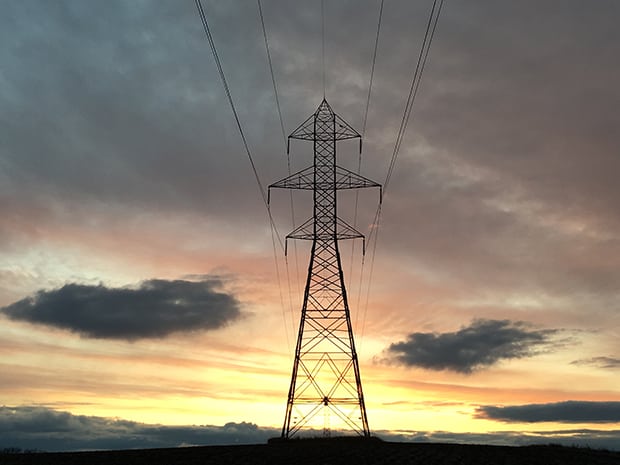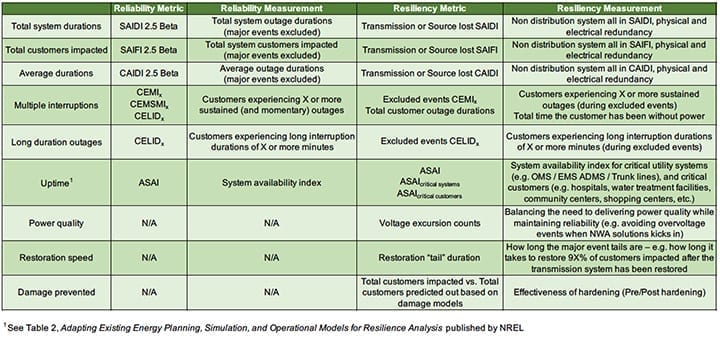Why Resiliency in the Electrical Grid Should Be Measured from the Customer’s Perspective
The post Why Resiliency in the Electrical Grid Should Be Measured from the Customer's Perspective appeared first on POWER Magazine.

Reliability performance is core to the utility industry. Utilities strategically design and invest in their system to maximize reliability performance-traditionally measured by System Average Interruption Frequency Index (SAIFI), System Average Interruption Duration Index (SAIDI), and/or Consumer Average Interruption Duration Index (CAIDI). These quantitative metrics largely drive utility investment decisions, shape strategic priorities, dictate regulatory approvals, and determine cost recovery. While these metrics are generally good indicators of system performance, the commonly used SAIFI/SAIDI/CAIDI indicators actually refer to blue sky" system performance, where hurricanes and other large and impactful outage events are not counted toward these reportable performance metrics. Therefore, long-duration outages that greatly inconvenience customers are unaccounted for in this view.
In addition to reliability, the concept of grid modernization is fundamental to utility success. To keep up with changing customer and technology demands on the electric system, utilities must invest in modernizing their capability and functionality; and then provide those additional capabilities to customers and ratepayers. Grid modernizing capabilities include optimizing technologies for restoration and monitoring, as well as modifying the distribution system away from a uni-directional feed design to facilitate a bi-directional feed system-allowing the connection to distributed energy resources, electric vehicles, etc. As these modernizations are planned and executed, utilities still measure their customer and regulatory performance by their ability to reliably deliver electricity. However, reliability success depending on these metrics remains somewhat myopic when it comes to making utility investment decisions, as it still fails to measure the value of delivering power to customers when they need it most-when it's out.
Until recently, the concept of measuring the grid based on its reliability performance and capabilities alone has been the norm. It's evident that we're experiencing severe weather impacts more frequently than we have in the past. The potential for outages from severe weather is compounded by additional threats facing the grid, like cyberattacks and global pandemics. Due to this, grid resiliency has become an increasingly critical topic. Resiliency-how quickly and effectively the grid can restore to normal operations after any major disruption-is the third pillar to a utility's future success.
Each year, PA Consulting hosts ReliabilityOne, an awards program that identifies the best reliability operations and practices across the utility industry. During the most recent certification program, leading utilities were found to be increasingly aware of the differences between reliability and resiliency, but there was not a consistent definition of what it means to be resilient. Utilities understand the importance of this new concept and how associated metrics will become increasingly important to governmental and regulatory drivers as much as reliability performance is currently.
Reliability, Grid Modernization, and Resiliency MetricsThe industry has declared the importance of these three topics-reliability, grid modernization, and resiliency-and the need for focused metrics to understand and prioritize investments across this multi-spectrum set of requirements for the betterment of customers, ratepayers, public safety, and the environment. While reliability and grid modernization can be measured from system performance, and is well-defined and widely accepted across the industry, we believe measuring resiliency should take on a different perspective. Since resiliency is solely measured during the time when the power is out, metrics should reflect the customer impact rather than report from the system's operating perspective. While there's no commonly accepted definition of system resiliency in the industry, customer's certainly have opinions and viewpoints regarding their system's ability to prevent or reduce the impact of long-duration power outages as a result of severe weather conditions.
As stated, the most commonly reported reliability statistics are focused on the performance of utility systems, and we believe that resiliency should be seen from the perspective of customer impact, so we developed some new measurements. These proposed metrics (Table 1) can help start a thoughtful and informed conversation and could ultimately lead to the industry accepting a set of metrics that will resonate with all stakeholders.
Resiliency Metrics Table 1. This table offers reliability and resilience metrics with a focus placed on impacts to customers. The National Renewable Energy Laboratory's (NREL's) report Adapting Existing Energy Planning, Simulation, and Operational Models for Resilience Analysis is another valuable resource on the topic. Source: PA ConsultingThe Move from Reactive to Proactive Utility Management
Table 1. This table offers reliability and resilience metrics with a focus placed on impacts to customers. The National Renewable Energy Laboratory's (NREL's) report Adapting Existing Energy Planning, Simulation, and Operational Models for Resilience Analysis is another valuable resource on the topic. Source: PA ConsultingThe Move from Reactive to Proactive Utility ManagementHistorically, utilities have retroactively evaluated resiliency needs and implemented initiatives to address storm-specific issues. According to a study conducted by the U.S. Department of Energy's Office of Electricity Delivery and Energy Reliability in 2010, since 2005, multiple State public utility commissions have issued rulemakings and/or regulatory activities related to electricity infrastructure hardening. Many of the transmission and distribution hardening and resiliency initiatives taken on by utilities have been in response to such regulation." The utility industry first published information regarding resiliency over 15 years ago, yet, we've seen limited progress on the topic and no tangible metrics.
More recently the New Jersey Board of Public Utilities required the state's utility providers to adhere to a new section of the State's Energy Master Plan regarding Infrastructure Resiliency & Emergency Preparedness Response addressing policy recommendations based on New Jersey's Plan for Action in the aftermath of Superstorm Sandy. In 2019, Florida signed into law a measure that requires utilities to submit a 10-year transmission and distribution storm protection plan to the Florida Public Service Commission to provide greater resiliency after several storms hit their system. Lastly, the California Public Utilities Commission gave electric utilities authority to shut off electric power in order to protect public safety during wildfires. These measures address current threats to resiliency but are retroactive in nature and are ultimately a result of customer dissatisfaction.
Yet, instead of approaching system resiliency from the response-side, utilities can proactively incorporate resiliency and hardening measures through traditional integrated resource planning. Utilities can design integrated resource plans to be inclusive of all standard and non-standard investment alternatives as the mechanism to use, deploy, and frame performance. Below are a few general readiness and storm-specific readiness resiliency measures utilities can implement today.
General Resiliency ReadinessVegetation Management. Perform regular vegetation management in addition to focused efforts in high-risk areas to reduce the likelihood and duration of a potential outage.
Distributed Energy Resources (DER) Saturation. Identify opportunities for the distribution system to leverage DERs (alternative generation, electric vehicles, storage, or other technology investments) to reduce the number of customers impacted, restore customer outages quicker, or prevent outages all together. Utilities could also provide financing options for residents interested in DER opportunities (microgrid, solar, storage, etc.).
Mutual Assistance Group Participation. Participate in established mutual assistance groups to obtain third-party assistance during major events, and reduce outage duration and restoration times. Utility partnerships with vendors to promote generator or fuel purchase for commercial or residential use is also essential to resiliency.
Spare Equipment. Store additional generation and/or restoration equipment near staging centers to allow for quicker restoration times and shorter outage durations.
Mobile Command Centers. Establish community/mobile command centers as the norm during major storm events where customers can access phones, internet, charging capability, dry ice, wood, propane, etc. Providing regular and widespread communications via mobile command centers would be critical to ensure customers have the information they need.
Undergrounding. Focus undergrounding efforts to higher-risk areas for damages and outages.
Pole Hardening. Conduct regular, proactive hardening efforts for poles that have reached, or neared, the end of their lifecycle and replace them with concrete poles in addition to focusing pole hardening efforts in higher-risk areas for outage.
Situational Awareness. Ubiquitous high-definition (HD) cameras, sensors, and isolation equipment coverage of high-risk areas (one example is San Diego Gas & Electric [SDG&E] and its HD fire watch cameras that are streamed online and citizens are encouraged to watch and report any activity). Further, expansion of bottom-up comprehensive asset awareness via risk assessment and categorization at the circuit/feeder increment level. This can be accomplished via deep analytics and modeling of each critical component, and the environment, condition, and maintenance of them.
Storm-specific Resiliency ReadinessPreparedness Training. Regular practiced training for storm-specific events, including performing drills, drives better restoration performance, which ultimately leads to improved outage times, smoother mutual assistance opportunities, and enhanced customer satisfaction.
Emergency Facility Identification. Prioritize critical facilities (senior citizens homes, neighborhood watch homes/centers, community centers, etc.) beyond critical customer groupings used today, and focus resiliency and hardening efforts in those areas to ensure they're covered to obtain a societal benefit.
Successful OutcomesUtilities that implement these resiliency measures can gain a better understanding of how effective the traditional resiliency plays are, and how they are, or are not, aligned with the overall grid modernization strategy. Below are some potential items to measure pre- and post-impact of implemented resiliency and hardening initiatives.
Metrics Based on the Topology of the System.
Component criticality:
- Switching effectiveness.
- Automated switching effectiveness.
- Spare fetch time.
Managing the tail of restoration:
- Measuring the difference or improvement of a certain percentage of customers with multiple power outages year-over-year storm after storm.
Identifying possible mitigations and customers positively impacted as a result of:
- Tree wire.
- Partial undergrounding.
- No pole left unhardened.
- Rear lot lines undergrounded.
- Water sensors.
- Line sensors coordinated with isolation schemes.
- Concrete poles.
- Insulated conductors.
To successfully measure the effectiveness of resiliency initiatives, utilities should focus on conducting proactive integrated resource planning in areas that improve the number of times that customers are without power, the frequency that customers lose power, and overall customer satisfaction as a result of major weather/climatic events. Including outages in reportable performance metrics gives companies a full view of how customers are impacted by service disruptions. This in turn gives utilities a better picture of where improvements are most needed to create more resilient systems.
-Gregg Edeson is PA Consulting's utility reliability and resiliency lead. He is a recognized leader with more than 40 years in the electric utility industry helping clients to excel in grid modernization efforts, asset management, and reliability improvement strategies, and assuring organizational value from IT/OT investments. A grid modernization expert, he works with senior leadership teams to implement operational improvement initiatives integrated with regulatory and labor strategies. Aleka Stevens is an energy and utilities expert at PA Consulting specializing in grid modernization and sustainability. She helps utilities across the U.S. develop clean energy strategies and leverage data to quantify the health of their assets.
The post Why Resiliency in the Electrical Grid Should Be Measured from the Customer's Perspective appeared first on POWER Magazine.